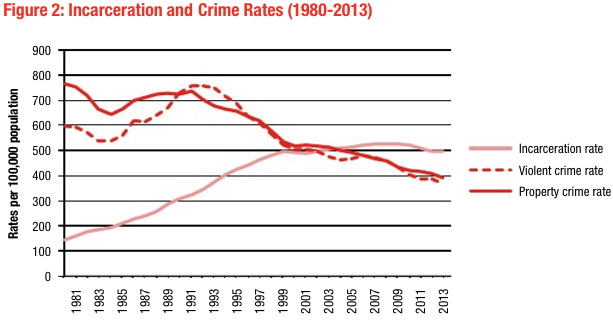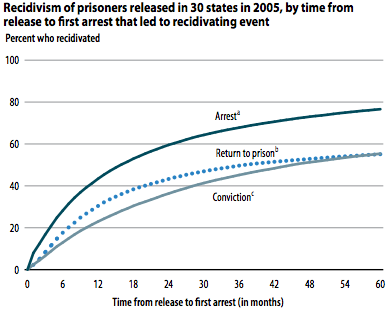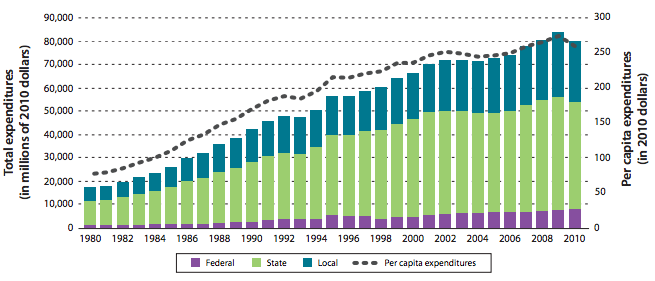Putting People in Prison Fails Both Them and You
By:
You've probably been hearing a lot lately about rolling back mass incarceration, scaling down the War on Drugs, and rethinking our approach to the criminal justice system. The reasons behind the recent trend among politicians, lawmakers, law enforcement leaders, and even celebrities, are manifold: The effects of the criminal justice system reach into all corners of society.
One big reason the tide seems to be turning is that incarceration, something of a linchpin in the grand design of criminal justice, isn't necessarily having the desired effects on lowering crime rates, keeping communities safe, and stunting recidivism (stopping offenders from reoffending after being locked up). Here's a break down of some reasons behind the phenomenon:
RELATED: The Ridiculous Reason 13-Year-Olds Are Getting Life Without Parole
1. Incarceration doesn't necessarily lead to lower crime rates
In recent decades, two trends have marked criminal justice in the U.S.: more incarceration, and less crime. A graph of this might make the case for both correlation and causation.
 The Brennan Center for Justice - brennancenter.org
The Brennan Center for Justice - brennancenter.org
But as a recent report by the Brennan Center for Justice at New York University's School of Law illustrated, while the two trends seem to be closely linked, they're not necessarily as connected as they seem: economist Joseph Stiglitz writes in the report's forward that researchers found "incarceration had relatively little to do with the crime decline." In fact, they conclude that while locking more people up caused about a five percent drop in crime in the 1990s, its potency has since diminished, now having no statistically positive effect.
RELATED: What It's Like To Spend 22 Years In Prison For A Crime You Didn't Commit
The authors explain that this can essentially be linked to the diminishing impact of "incapacitation," a criminology term implying that keeping offenders locked away from society cancels out the crimes they would otherwise commit. Over the years, incarcerating non-violent drug offenders and low-level criminals—which now make up a majority of federal prisoners, and nearly half of state prisoners—has yielded less crime reduction per each prisoner locked up. While incarceration played some role, researchers don't exactly know what caused crime rates to plummet, but the explanations include methods of policing, abortion, unemployment, and unleaded gasoline.
2. Incarceration does not always lead to lower reoffence rates
One idea behind incarcerating people is that the punishment will effectively teach them a lesson, and deter future crime. But recidivism rates remain fairly high in the U.S.; according to the Bureau of Justice Statistics, about two in three prisoners, 68 percent, were arrested for a new crime after three years of being released from prison, with 77 percent being arrested after five years.
 Bureau of Justice Statistics - bjs.gov
Bureau of Justice Statistics - bjs.gov
Recidivism rates have led to a focus on rehabilitative efforts both within and outside of prison walls that teach incarcerated individuals skills, provide therapy, education, and help ease the reintegration process. Still, those efforts are often not enough: life for formerly incarcerated people is often marked by hardship in finding employment, stable housing, and sustainable financial situations. It's only recently that states have moved to make some public assistance programs like food stamps available for felons. With widespread incarceration and a weak rehabilitative infrastructure, it's no wonder recidivism rates are so high.
3. With waning effectiveness, incarceration still costs Americans billions
Prison populations are not the only things that have increased exponentially in recent decades. Whereas each U.S. taxpaying person spent about $77 on incarceration in 1980, that number has more than tripled since. According to a report from the Hamilton Project of the Brookings Institution last year, each person in the U.S. pays about $260 each year to make up the annual $80 billion we spend on incarcerating people.
 The Hamilton Project/Brookings Institute - brookings.edu
The Hamilton Project/Brookings Institute - brookings.edu
